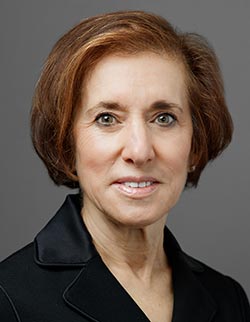Lupus and APS Center
World-class, patient-centered medical care, research, support and education
The goal of the Lupus and Antiphospholipid Syndrome (APS) Center of Excellence is to provide the highest quality of care to enhance our patients’ lives. Lupus and APS are autoimmune diseases that are highly variable from patient to patient and unpredictable over the course of any one patient’s life. We are here to help you manage your illness by providing individualized care and support to meet your specific needs.
Expertise in the most challenging areas
- Complex cases - our rheumatologists and interdisciplinary team work closely with specialists in other medical disciplines including nephrology, obstetrics and gynecology, dermatology, psychiatry, neurology, cardiology, hematology/oncology, and pain management.
- Lupus nephritis - a serious and relatively common complication of SLE that requires an integrated approach and collaboration from multiple departments and specialties. View our Lupus Nephritis Program
Fast Track Appointment Referral Service
If you are a new patient in need of lupus care, please call us today.
- Pregnancy - mothers with lupus are at a higher risk to develop complications. Specialized care, education and precautions can lead to a successful birth. View our Reproductive Health Program
- APS - blood clots from APS can lead to life threatening complications like deep vein thrombosis (DVT), pulmonary embolism, heart attacks and strokes. HSS is a leading center for APS research and treatment.
- Unspecified disease - those who have too many symptoms, not enough symptoms, or abnormal blood tests with no symptoms can be left undiagnosed or untreated without help from an experienced rheumatologist.
- Pediatric rheumatology - young children and teenagers affected by lupus and APS are treated by pediatric specialists until they reach the age where they can transition to adult care.
Lupus Newsletter - Sign Up
Our quarterly newsletter provides the latest updates to lupus research and treatment, as well as events and news. Sign up today or view our previous newsletters below:
Physicians and Staff
Our HSS lupus and APS specialists have decades of experience caring for patients, compassionately applying their knowledge to each individual under their care. They coordinate care with specialists in other fields to help manage a patient's whole health status. Combining research advances from HSS scientists and other researchers with deep clinical expertise enables us to provide a tailored, evidence-based approach. Our non-clinical staff provides programming, education and support, while the research coordinators enable patients to partner with us in the pursuit of better medical outcomes.
Physicians
Research Scientists
Rheumatology Fellows
Sandhya Kannayiram, MD
Kelvin Chan, MD, PhD
Alex Luta, MD
Julia Levy, MD
Cara Murphy, MD
Marissa Savoie, MD
Zeynep Erton, MD
Harry Hurley, MD, PhD
Kiera Brennan, MD
Hillary Weisleder, MD
Nurses
Fabienne Fontenette – Manager, Ambulatory Services
Alanna Little, RN – Assistant Manager, Ambulatory Services
Mia Anderson, RN
Julius Bugante, RN
Maria Corazon Roque, RN
Hannah Harrill, RN
Taylor Karren, RN
Camilla Laing, RN
Cara Loftus, RN
Helen Pham, RN
Michelle Ramirez, RN
Nikki Sembrano, RN
Greg Tavani, RN
Rachelle Williams, RN
Ludis Williams-Mitchell, RN
Kelly Wong, RN
Multispecialty Collaborating Physicians
The HSS Lupus and APS Center of Excellence has established relationships with physicians across the spectrum of medical and surgical specialties as we work to provide our patients with comprehensive evidence-based compassionate care. Each specialist listed below has expressed a commitment to working with our patients and the Center.
Patients contacting any of these physicians should verify whether the physician participates in their health insurance plan prior to confirming an appointment.
Cardiology:
Rebecca R. Ascunce, MD
Weill Cornell Medicine
P: 646.962.5558
Hooman Yaghoobzadeh, MD
Weill Cornell Medicine
P: 212.861.3222
Evelyn M. Horn, MD
Weill Cornell Medicine
P: 646.962.5555
Maria Karas, MD
Weill Cornell Medicine
P: 646.962.5555
Irina Sobol, MD
Weill Cornell Medicine
P: 646.962.5555
Dermatology:
Joanna L. Harp, MD
Weill Cornell Medicine
P: 646.962.3376
Henry J. Lee, MD, PhD
Weill Cornell Medicine
P: 646.962.3376
Horatio F. Wildman, MD
Weill Cornell Medicine
P: 646.962.3376
Julie Zang, MD
Weill Cornell Medicine
P: 646.962.3376
Endocrinology:
Jessica Rachel Starr, MD
Hospital for Special Surgery
P: 212.606.1618
Emily Margaret Stein, MD, MS
(Metabolic Bone)
Hospital for Special Surgery
P: 212.606.1970
Rekha Kumar, MD
(Weight Management)
Weill Cornell Medicine
P: 212.821.0924
Gastroenterology:
Aaron Lambroza, MD
Weill Cornell Medicine
P: 212.517.7570
Brian Landzberg, MD
Weill Cornell Medicine
P: 212.737.5000
Amir Soumekh, MD
Weill Cornell Medicine
P: 212.746.4014
Gil Weitzman, MD
Weill Cornell Medicine
P: 212.249.3720
General Surgery:
Faith A. Menken, MD
Weill Cornell Medicine
P: 212.439.9547
Hematology/Oncology:
Pinkal Desai, MD
Hospital for Special Surgery
P: 646.962.2700
Raymond D. Pastore, MD
Weill Cornell Medicine
Center for Blood Disorders
P: 646.962.2065
Samuel Yamshon, MD
Weill Cornell Medicine (Hematology/Oncology)
P: 646.962.2064
Infectious Disease:
Andy O. Miller, MD
Hospital for Special Surgery
P: 212.774.2317
Michael W. Henry, MD
Hospital for Special Surgery
P: 212.774.7113
Elizabeth Robilotti, MD
Hospital for Special Surgery
P: 212.774.7052
Michael J. Satlin, MD, MS
Weill Cornell Medicine
P: 646.962.8747
Maternal-Fetal Medicine:
Robin B. Kalish, MD, FACOG
Weill Cornell Medicine
P: 212.746.3146
Inna V. Landres, MD, FACOG
Weill Cornell Medicine
P: 212.746.3064
Shai M. Pri-Paz, MD, FACOG
Weill Cornell Medicine
P: 212.746.3440
Nephrology:
James Chevalier, MD
The Rogosin Institute,
NewYork-Presbyterian Hospital
P: 212.746.4761
Frank Liu, MD
The Rogosin Institute,
NewYork-Presbyterian Hospital
P: 212.746.1556
Neurology:
Jai S. Perumal, MD
Weill Cornell Medicine
P: 646.962.9800 Option: #3
Babak Navi, MD
Weill Cornell Medicine
(Vascular/ Stroke Neurology)
P: 212.746.0225
Obstetrics/Gynecology:
Wing Kay Fok, MD, MS, FACOG
Weill Cornell Medicine
P: 646.962.4900
Ophthalmology:
Marc J. Dinkin, MD
Weill Cornell Medicine
P: 646.962.4297
Mrinali Patel Gupta, MD
Weill Cornell Medicine
P: 646.962.2020
Psychology:
Pulmonology:
Anna Podolanczuk, MD
Weill Cornell Medicine
P: 646.962.2333
Robert Jeffrey Kaner, MD
Weill Cornell Medicine
P: 646.962.2333
Kerri Aronson, MD
Weill Cornell Medicine
P: 646.962.2333
Renal Pathology:
Surya V. Seshan, MB, BS
Weill Cornell Medicine
P: 212.746.6455
Reproductive Endocrinology/Infertility:
David Reichman, MD
Weill Cornell Medicine
P: 646.962.7499
Glenn L. Schattman, MD
Weill Cornell Medicine
P: 646.962.3836
Steven D. Spandorfer, MD
Weill Cornell Medicine
P: 646.962.3638
Lupus and APS Center Staff
Manager, Lupus and APS Center of Excellence
Department of Social Work Programs
Vice President (VP), Chief Equity Officer
Director, Department of Social Work Programs
Program Coordinator, Charla de Lupus (Lupus Chat)®
Senior Program Associate, LANtern® (Lupus Asian Network)
Social Work Manager of the Rheumatology Division
Manager VOICES 60+ Senior Advocacy Program
Social Worker, VOICES 60+
Adult Rheumatology Social Worker
Lupus and APS Clinical Research Coordinators and Assistants
Marta Guerra – IMPACT & PROMISSE Project Coordinator (Dr. Jane Salmon)
Noel Ermer – Clinical Research Coordinator (Dr. Timothy Niewold & Dr. Caroline Siegel)
Natasha Zarrin – Clinical Research Coordinator (Dr. Kyriakos Kirou & Dr. Mary Crow)
JoAnn Vega – Research Manager and Clinical Research Coordinator (Dr. Medha Barbhaiya & Dr. Doruk Erkan)
Lupus and APS Articles and Education
The article links below are intended for those who have symptoms, have been diagnosed or have complications from lupus, lupus nephritis or APS. For professional health education, please see the Research & Professionals tab (on this page) and the HSS Education Institute.
Managing Lupus
- Managing and Treating Lupus
- Lupus Blood Test Results Explained
- Dealing with Uncertainty in Your Lupus Diagnosis
- Lupus Nephritis: What You Should Know About Lupus and Kidney Disease
- Lupus Across the Lifespan: SLE in Children, Teenagers, Adults and Seniors
Related Symptoms and Conditions
- Lupus and Fatigue
- Antiphospholipid Syndrome and Coronavirus Disease 2019 (COVID-19) – Top 10 Series
- Lupus and Heart Conditions – Top 10 Series
- Managing Arthritis in Lupus
- Lupus, Osteoporosis and Bone Health
- Lupus Fog – Changes in Memory and Thinking
- Prevention of Blood Clots in Antiphospholipid Antibody-Positive Patients – Top 10 Series
- Cutaneous Lupus and Lupus Rashes: What You Need to Know
- Heart Health and Chronic Inflammatory Disorders
- Possible Environmental Triggers Associated With Autoimmune Diseases
Wellness and Prevention
- How Exercise Can Help You Build Better Bones
- Nutrition and Lupus: How to Maintain a Healthy Diet
- Nutrition for Lupus-related Conditions: Heart and Kidney Disease
- Getting Exercise and Keeping Physically Fit While Living with Lupus
- Vaccinations and Lupus: What You Should Know
- Sun Protection and Connective Tissue Disease
Additional Resources
Managing APS
- Pediatric Antiphospholipid Syndrome – Top 10 Series
- Classification Versus Diagnosis of Antiphospholipid Syndrome: How Are They Different? – Top 10 Series
- Antiphospholipid Syndrome Terminology – Top 10 Series
- Antiphospholipid Syndrome and Potential New Treatments – Top 10 Series
Pregnancy and Reproductive Health
- Lupus and Contraception: Essentials for Patients
- Pregnancy and Lupus: Risks and Best Practices
- Antiphospholipid Syndrome (APS) and Pregnancy – Top 10 Series
Emotional Well-Being and Health Support
Recent Webinars and Recorded Events
- Lupus and the Kidneys: What You Should Know (March 2024) featuring Kyriakos A. Kirou, MD
- Sexual Health Pregnancy and Lupus (May 2023) featuring Caroline Siegel, MD
- Understanding Lab Tests and Results for SLE (May 2023) featuring Sarah Lieber, MD, MS
- COVID-19 Updates for Patients with Lupus (May 2022) featuring Andy Miller, MD
- The Uncertainty of Lupus and Other Diagnoses (March 2022) featuring Michael Lockshin, MD
- What's New in Lupus Research and How to Participate (from December 20, 2021) featuring Kyriakos A. Kirou, MD
Annual Events
- Lupus Awareness Month - May
- World Lupus Day - May 10
- Walk to Cure Lupus - October
See all of our community events and classes.
Lupus and APS Support Programs
Having access to high quality medical care and resources for social, emotional, and other support can empower you to care for yourself and improve the quality of your life. We offer the following resources and programs to patients and their families:
- Lupus Support Programs and Social Work Services - free for patients and their loved ones
- Lupus Nephritis Program
- Physical Therapy Services
- Occupational Therapy Services
- Rheumatology Clinic - medical care for patients with public health insurance or no insurance
- Rheumatology Reproductive Health Program
If you have any questions about our lupus and APS programs or are a new patient looking for care email us.
Lupus and APS Research
Scientists and clinicians at HSS are constantly working to advance understanding of the causes of disease and develop novel treatments for lupus and APS. In partnership with our patients, significant progress has been made.
Presentations (see our Webinars and Events tabs for more)
- Update on New Therapies for Lupus, including Car-T Cell Therapy & More
- What's New in Lupus Research and How to Participate
- Lupus and COVID-19 Emerging Research | View slides
- Patient Participation in Medical Research for Lupus
Our research efforts
You can also participate in our observational studies and clinical trials:
Patients have the right to stop participation in a research study at any time. If you would like to obtain more information or to see if you qualify for a study or trial, contact 1.877.SLE.CURE.
Professional Education
Grand Rounds: Management of Complex Cases: this publication profiles highly complicated cases at HSS in full detail with follow-up data and a discussion on clinical treatment.
- November 2024 | Volume 13, Issue 3 | Rheumatology Issue
- November 2023 | Volume 12, Issue 3 | Rheumatology Issue
- November 2022 | Volume 11, Issue 3 | Rheumatology Issue
Journal Articles and Publications: published articles on PubMed
HSS Professional Newsletters: Subscribe to Rheumlink, our professional rheumatology newsletter
Lupus and APS Center Videos

Director of the Center, Jane Salmon, MD discusses the Center's mission and goals in a quick one-minute video.

HSS Rheumatologist, Lisa Sammaritano, MD talks about reproductive health issues facing women with lupus.

Pediatric rheumatologists explain the key points for preparing children to move from child-centered to adult-centered care.
Our patients say it best. Read their stories.
Lupus and APS Center in the News
- Why Are My Hands and Feet So Cold?
- New SLE Guidelines Endorse Expanding HCQ, Restricting Glucocorticoids
- ACR Issues First Update to Lupus Guideline Since 1999
- How Does Menopause Impact Your Autoimmune Disease?
- Lupus: 11 Things Doctors Want You to Know
- Past ACR President Named a PANLAR Master
- A Cutting-Edge Cancer Therapy Offers Hope for Patients With Lupus
- HSS Study at EULAR 2025 Congress Uses an AI Model to Predict Readmissions of Pregnant Women with Lupus Based on Social Determinants of Health
- My Lupus Symptoms Went Away During Pregnancy—but Returned With a Vengeance Postpartum
- Pregnant mothers with lupus face risks but have better outlooks than ever before, doctor says
- Social Isolation a Common Theme Among Older People With SLE
- Need Help With Lupus Nephritis Management? ACR Has Your Back
- 2024 Lupus Guideline
- Lupus Research Alliance Grants Lupus Innovation Awards to Eleven Talented Researchers to Accelerate Pace of Discovery in Lupus Research
- 9 Essential Questions to Ask About Managing Lupus
- HSS Participates in Promising Phase 3 Lupus Trial of Investigational Therapy DZP
- HSS Presents New Research at the ACR Convergence 2024
- What to Know About How Lupus Affects Weight
- Lupus Research Alliance Announces Inaugural Recipients of Translational Bridge Award
- Lupus research focusing on earlier diagnoses, HSS chief doctor says
- Direct-to-Consumer Rheumatologic Tests Carry Some Benefit but Plenty of Potential Risk
- Making Sense of the Connection Between Vaccines and Lupus Flares
- Challenges of designing and conducting cohort studies and clinical trials in populations of pregnant people
- Understanding lupus processes helps identify ‘important targets’ for intervention
- Steroid Use Higher than Expected in Patients with Lupus
- Interferons in Systemic Lupus Erythematosus
- APOL1 High-Risk Genotype in SLE: A Genes in Context Story
- HSS Presents New Reproductive Health Research at the ACR Convergence 2023
- New Antiphospholipid Syndrome Research Findings Presented at ACR Convergence 2023
- Studying the ‘Dark Matter’ of the Genome May Reveal a Deeper Understanding of Lupus
- What Drives Lupus and What are Potential Treatment Approaches?
- Lupus During Pregnancy Carries Higher Maternal, Fetal Morbidity Risks
- How to Navigate Pregnancy With Lupus
- Nadler Announces Over $24 Million in Funding for Hospitals on Manhattan’s East Side
- Experts share real-world experience prescribing voclosporin, belimumab for lupus nephritis
- HSS Research Institute and The University of Utah Receive NIH Grant to Continue Groundbreaking Study on Pregnant Patients with Antiphospholipid Syndrome Patients with or without Lupus
- Hospital for Special Surgery Research Institute Awarded Two New Grants to Study Potential Causes of Lupus Flares
- Fall 2022’s Awards, Appointments & Announcements in Rheumatology
- HSS Research Uncovers How UV Light Triggers Immune Activation and Disease Flares in Lupus
- Study Finds Chronic-Pain Management, Falls and Limited Access to Care Are Critical Issues Among Medically Underserved
- Cytokines and Rheumatic Diseases
- Participation Doubles After Lupus Support Group at HSS Transitions to Virtual Format During Pandemic
- HSS Presents New Research at the ACR Convergence 2022
- HSS Rheumatologists, Social Worker Honored by American College of Rheumatology
- Lupus, coronary artery disease share genetic risk factors; data may lead to early testing
- CBS Saturday Morning
- In Small Study, CAR-T Therapy Pushes Lupus Into Remission
- Women In Wellness: Dr. Ashira Blazer of Hospital for Special Surgery (HSS) On The Five Lifestyle Tweaks That Will Help Support People’s Journey Towards Better Wellbeing
- Lupus, MS and Other Autoimmune Disorders Raise Heart Risks
- Overcoming the Uncertainties of Living with Chronic Diseases like Lupus

















